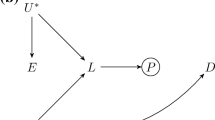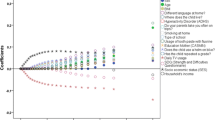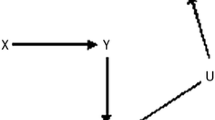Abstract
Objective This research aims to identify predictors of attrition in a longitudinal birth cohort study in Australia and assess differences in baseline characteristics and responses in subsequent follow-up phases between contactable non-responders and uncontactable non-responders deemed “lost to follow-up (LTF)”. Methods 3368 women recruited from three public hospitals in Southeast Queensland and Northern New South Wales during antenatal visits in 2006–2011 completed a baseline questionnaire to elicit information on multiple domains of exposures. A follow-up questionnaire was posted to each participant at 1 year after birth to obtain mother’s and child’s health and development information. Multivariate logistic regression was used to model the association between exposures and respondents’ status at 1 year. The effect of an inverse-probability-weighting method to adjust for non-response was studied. Results Overall attrition at 1-year was 35.4 %; major types of attrition were “contactable non-response” (27.6 %) and “LTF” (6.7 %). These two attrition types showed different responses at the 3-year follow-up and involved different predictors. Besides shared predictors (first language not English, higher risk of psychological distress, had smoked during pregnancy, higher levels of family conflict), distinguishable predictors of contactable non-responders were younger age, having moved home in the past year and having children under 16 in the household. Attrition rates increased substantially from 20 % in 2006 to 54 % in 2011. Conclusions This observed trend of increased attrition rates raises concern about the use of traditional techniques, such as “paper-based” questionnaires, in longitudinal cohort studies. The supplementary use of electronic communications, such as online survey tools and smart-device applications, could provide a better alternative.


Similar content being viewed by others
References
Atherton, K., Fuller, E., Shepherd, P., et al. (2008). Loss and representativeness in a biomedical survey at age 45 years: 1958 British birth cohort. Journal of Epidemiology and Community Health, 62, 216–223.
Seaman, S. R., & White, I. R. (2013). Review of inverse probability weighting for dealing with missing data. Statistical Methods in Medical Research, 22, 278–295.
Golding, J., & Birmingham, K. (2009). Enrolment and response rates in a longitudinal birth cohort. Paediatric and Perinatal Epidemiology, 23, 73–85.
Ng, S. K., Cameron, C. M., Hills, A. P., et al. (2014). Socioeconomic disparities in prepregnancy BMI and impact on maternal and neonatal outcomes and postpartum weight retention: The EFHL longitudinal birth cohort study. BMC Pregnancy and Childbirth, 14, 314.
Bellon, J. A., de Dios Luna, J., Moreno, B., et al. (2010). Psychosocial and sociodemographic predictors of attrition in a longitudinal study of major depression in primary care: The predictD-Spain study. Journal of Epidemiology and Community Health, 64, 874–884.
Lamers, F., Hoogendoorn, A. W., Smit, J. H., et al. (2012). Sociodemographic and psychiatric determinants of attrition in the Netherlands Study of Depression and Anxiety (NESDA). Comprehensive Psychiatry, 53, 63–70.
Mein, G., Johal, S., Grant, R. L., et al. (2012). Predictors of two forms of attrition in a longitudinal health study involving ageing participants: An analysis based on Whitehall II study. BMC Medical Research Methodology, 12, 164.
Weuve, J., Tchetgen, E. J., Glymour, M. M., et al. (2012). Accounting for bias due to selective attrition: The example of smoking and cognitive decline. Epidemiology, 23, 119–128.
Zhivan, N. A., Ang, A., Amaro, H., et al. (2012). Ethnic/race differences in the attrition of older American survey respondents: Implications for health-related research. Health Services Research, 47, 241–254.
Kurewa, N. E., Gumbo, F. Z., Mapingure, P. M., et al. (2012). Predictors of attrition among children born in a PMTCT Programme in Zimbabwe followed up over 5 years. Journal of Tropical Pediatrics, 58, 360–369.
Zook, P. M., Jordan, C., Adams, B., et al. (2010). Retention strategies and predictors of attrition in an urban pediatric asthma study. Clinical Trials, 7, 400–410.
Watson, N., & Wooden, M. (2004). Sample attrition in the HILDA survey. Australian Journal of Labour Economics, 7(2), 293–308.
Richter, L. M., Norris, S. A., & De Wet, T. (2004). Transition from birth to ten to birth to twenty: The South African cohort reaches 13 years of age. Paediatric and Perinatal Epidemiology, 18, 290–301.
Cameron, C. M., Scuffham, P. A., Spinks, A., et al. (2012). Environments for Healthy Living (EFHL) Griffith birth cohort study: Background and methods. Maternal and Child Health Journal, 16, 1896–1905.
Cameron, C. M., Scuffham, P. A., Shibl, R., et al. (2012). Environments for Healthy Living (EFHL) Griffith birth cohort study: Characteristics of sample and profile of antenatal exposures. BMC Public Health, 12, 1080.
Ng, S. K., Olog, A., Spinks, A. B., et al. (2010). Risk factors and obstetric complications of large for gestational age births with adjustments for community effects: Results from a new cohort study. BMC Public Health, 10, 460.
Furukawa, T. A., Kessler, R. C., Slade, T., et al. (2003). The performance of the K6 and K10 screening scales for psychological distress in the Australian National Survey of Mental Health and Well-being. Psychological Medicine, 33, 357–362.
Kessler, R. C., Barker, P. R., Colpe, L. J., et al. (2003). Screening for serious mental illness in the general population. Archives of General Psychiatry, 60, 184–189.
World Health Organisation. (1998). Obesity: preventing and managing the global epidemic. Geneva: WHO.
Moos, R., & Moos, B. (1994). Family environment scale manual: Development, applications, research (3rd ed.). Palo Alto, California: Consulting Psychologist Press.
American College of Obstetricians & Gynecologists. (2000). Fetal macrosomia. ACOG practice bulletin, no. 22. Washington: ACOG.
Hofler, M., Pfister, H., Lieb, R., et al. (2005). The use of weights to account for non-response and drop-out. Social Psychiatry and Psychiatric Epidemiology, 40, 291–299.
Bambs, C. E., Kip, K. E., Mulukutla, S. R., et al. (2013). Sociodemographic, clinical, and psychological factors associated with attrition in a prospective study of cardiovascular prevention: The Heart Strategies Concentrating on Risk Evaluation study. Annals of Epidemiology, 23, 328–333.
Rao, R. S., Sigurdson, A. J., Doody, M. M., et al. (2005). An application of a weighting method to adjust for nonresponse in standardized incidence ratio analysis of cohort studies. Annals of Epidemiology, 15, 129–136.
Little, R. J. A., & Rubin, D. B. (2002). Statistical analysis with missing data. New Jersey, NJ: Wiley.
Wiggins, R. D., Schofield, P., Sacker, A., et al. (2004). Social position and minor psychiatric morbidity over time in the British Household Panel Survey 1991–1998. Journal of Epidemiology and Community Health, 58, 779–787.
Thompson, C. A., & Arah, O. A. (2014). Selection bias modeling using observed data augmented with imputed record-level probabilities. Annals of Epidemiology, 24, 747–753.
Schmidt, C. O., Raspe, H., Pfingsten, M., et al. (2011). Does attrition bias longitudinal population-based studies on back pain? European Journal of Pain, 15, 84–91.
Alderman, H., Behrman, J., Kohler, H. P., et al. (2001). Attrition in longitudinal household survey data: Some tests from three developing countries. Demographic Research, 5(4), 79–124.
Gustavson, K., Soest, T. V., Karevold, E., et al. (2012). Attrition and generalizability in longitudinal studies: Findings from a 15-year population-based study and a Monte Carlo simulation study. BMC Public Health, 12, 918.
Dillon, D. G., Pirie, F., Rice, S., et al. (2014). Open-source electronic data capture system offered increased accuracy and cost-effectiveness compared with paper methods in Africa. Journal of Clinical Epidemiology, 67, 1358–1363.
de Vries, H., Logister, M., Krekels, G., et al. (2012). Internet-based computer tailored feedback on sunscreen use. Journal of Medical Internet Research, 14, e48.
Farmer, J. E., Clark, M. J., Mayfield, W. A., et al. (2014). The relationship between the medical home and unmet needs for children with autism spectrum disorders. Maternal and Child Health Journal, 18, 672–680.
Smith, B., Smith, T. C., Gray, G. C., et al. (2007). When epidemiology meets the internet: Web-based surveys in the Millennium Cohort Study. American Journal of Epidemiology, 166(11), 1345–1354.
Kalb, L. G., Cohen, C., Lehmann, H., et al. (2012). Survey non-response in an internet-mediated longitudinal autism research study. Journal of the American Medical Informatics Association, 19, 668–673.
Jorm, L. R., Walter, S. R., Lujic, S., et al. (2010). Home and community care services: A major opportunity for preventive health care. BMC Geriatrics, 10, 26.
Setiawan, V. W., Vimig, B. A., Porcel, J., et al. (2015). Linking data from the multiethnic cohort study to medicare data: Linkage results and application to chronic disease research. American Journal of Epidemiology, 181(11), 917–919.
Acknowledgments
The research reported in this publication is part of the Griffith Study of Population Health: Environments for Healthy Living (EFHL) (Australian and New Zealand Clinical Trials Registry: ACTRN12610000931077). Core funding to support EFHL is provided by Griffith University. The EFHL project was conceived by Professor Rod McClure, Dr Cate Cameron, Professor Judy Searle, and Professor Ronan Lyons. The authors are thankful for the contributions of the Project Manager, and the current and past Database Managers. The authors gratefully acknowledge the administrative staff, research staff, and the hospital antenatal and birth suite midwives of the participating hospitals for their valuable contributions to the study, in addition to the expert advice provided by Research Investigators throughout the project.
Author information
Authors and Affiliations
Corresponding author
Ethics declarations
Conflict of interest
The authors declare that there are no competing interests.
Rights and permissions
About this article
Cite this article
Ng, SK., Scott, R. & Scuffham, P.A. Contactable Non-responders Show Different Characteristics Compared to Lost to Follow-Up Participants: Insights from an Australian Longitudinal Birth Cohort Study. Matern Child Health J 20, 1472–1484 (2016). https://doi.org/10.1007/s10995-016-1946-8
Published:
Issue Date:
DOI: https://doi.org/10.1007/s10995-016-1946-8




